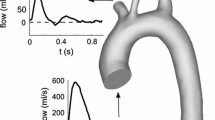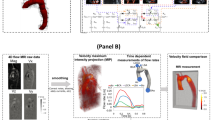Abstract
Late morbidity of surgically repaired coarctation of the aorta includes early cardiovascular and cerebrovascular disease, shortened life expectancy, abnormal vasomodulator response, hypertension and exercise-induced hypertension in the absence of recurrent coarctation. Observational studies have linked patterns of arch remodeling (Gothic, Crenel, and Romanesque) to late morbidity, with Gothic arches having the highest incidence. We evaluated flow in native and surgically repaired aortic arches to correlate respective hemodynamic indices with incidence of late morbidity. Three dimensional reconstructions of each remodeled arch were created from an anatomic stack of magnetic resonance (MR) images. A structured mesh core with a boundary layer was generated. Computational fluid dynamic (CFD) analysis was performed assuming peak flow conditions with a uniform velocity profile and unsteady turbulent flow. Wall shear stress (WSS), pressure and velocity data were extracted. The region of maximum WSS was located in the mid-transverse arch for the Crenel, Romanesque and Native arches. Peak WSS was located in the isthmus of the Gothic model. Variations in descending aorta flow patterns were also observed among the models. The location of peak WSS is a primary difference among the models tested, and may have clinical relevance. Specifically, the Gothic arch had a unique location of peak WSS with flow disorganization in the descending aorta. Our results suggest that varied patterns and locations of WSS resulting from abnormal arch remodeling may exhibit a primary effect on clinical vascular dysfunction.





Similar content being viewed by others
References
Cohen, M., V. Fuster, P. M. Steele, D. Driscoll, and D. C. McGoon. Coarctation of the aorta. Long-term follow-up and prediction of outcome after surgical correction. Circulation 80:840–845, 1989.
Puranik, R., V. T. Tsang, S. Puranik, et al. Late magnetic resonance surveillance of repaired coarctation of the aorta. Eur. J. Cardiothorac. Surg. 36:91–95, 2009 (discussion 95).
Warnes, C. A., R. G. Williams, T. M. Bashore, et al. ACC/AHA 2008 guidelines for the management of adults with congenital heart disease: a report of the American College of Cardiology/American Heart Association Task Force on Practice Guidelines (Writing Committee to Develop Guidelines on the Management of Adults With Congenital Heart Disease). Developed in Collaboration With the American Society of Echocardiography, Heart Rhythm Society, International Society for Adult Congenital Heart Disease, Society for Cardiovascular Angiography and Interventions, and Society of Thoracic Surgeons. J. Am. Coll. Cardiol. 52:e1–e121, 2008.
de Divitiis, M., C. Pilla, M. Kattenhorn, et al. Vascular dysfunction after repair of coarctation of the aorta: impact of early surgery. Circulation 104:I165–I170, 2001.
Mack, G., G. H. Burch, and D. J. Sahn. Coarctation of the aorta. Curr. Treat. Options Cardiovasc. Med. 1:347–354, 1999.
Webb, G. Treatment of coarctation and late complications in the adult. Semin. Thorac. Cardiovasc. Surg. 17:139–142, 2005.
Ou, P., E. Mousseaux, D. S. Celermajer, et al. Aortic arch shape deformation after coarctation surgery: effect on blood pressure response. J. Thorac. Cardiovasc. Surg. 132:1105–1111, 2006.
Hoimyr, H., T. D. Christensen, K. Emmertsen, et al. Surgical repair of coarctation of the aorta: up to 40 years of follow-up. Eur. J. Cardiothorac. Surg. 30:910–916, 2006.
Hager, A., S. Kanz, H. Kaemmerer, C. Schreiber, and J. Hess. Coarctation Long-term Assessment (COALA): significance of arterial hypertension in a cohort of 404 patients up to 27 years after surgical repair of isolated coarctation of the aorta, even in the absence of restenosis and prosthetic material. J. Thorac. Cardiovasc. Surg. 134:738–745, 2007.
Seirafi, P., K. Warner, R. L. Geggel, et al. Repair of coarctation of the aorta during infancy minimizes the risk of late hypertension. Ann. Thorac. Surg. 66:1378–1382, 1998.
Ou, P., D. Bonnet, L. Auriacombe, et al. Late systemic hypertension and aortic arch geometry after successful repair of coarctation of the aorta. Eur. Heart J. 25:1853–1859, 2004.
Ou, P., D. S. Celermajer, E. Mousseaux, et al. Vascular remodeling after “successful” repair of coarctation: impact of aortic arch geometry. J. Am. Coll. Cardiol. 49:883–890, 2007.
Glor, F. P., J. J. Westenberg, J. Vierendeels, M. Danilouchkine, and P. Verdonck. Validation of the coupling of magnetic resonance imaging velocity measurements with computational fluid dynamics in a U bend. Artif. Organs 26:622–635, 2002.
Leuprecht, A., K. Perktold, S. Kozerke, and P. Boesiger. Combined CFD and MRI study of blood flow in a human ascending aorta model. Biorheology 39:425–429, 2002.
Wood, N. B., S. J. Weston, P. J. Kilner, A. D. Gosman, and D. N. Firmin. Combined MR imaging and CFD simulation of flow in the human descending aorta. J. Magn. Reson. Imaging 13:699–713, 2001.
Frauenfelder, T., E. Boutsianis, T. Schertler, et al. Flow and wall shear stress in end-to-side and side-to-side anastomosis of venous coronary artery bypass grafts. Biomed. Eng. Online 6:35, 2007.
Ensley, A. E., P. Lynch, G. P. Chatzimavroudis, C. Lucas, S. Sharma, and A. P. Yoganathan. Toward designing the optimal total cavopulmonary connection: an in vitro study. Ann. Thorac. Surg. 68:1384–1390, 1999.
Soerensen, D. D., K. Pekkan, D. de Zelicourt, et al. Introduction of a new optimized total cavopulmonary connection. Ann. Thorac. Surg. 83:2182–2190, 2007.
Pizarro, C., and M. R. De Leval. Surgical variations and flow dynamics in cavopulmonary connections: a historical review. Semin. Thorac. Cardiovasc. Surg. Pediatr. Card Surg. Annu. 1:53–60, 1998.
Frydrychowicz, A., R. Arnold, D. Hirtler, et al. Multidirectional flow analysis by cardiovascular magnetic resonance in aneurysm development following repair of aortic coarctation. J. Cardiovasc. Magn. Reson. 10:30, 2008.
Frydrychowicz, A., A. F. Stalder, M. F. Russe, et al. Three-dimensional analysis of segmental wall shear stress in the aorta by flow-sensitive four-dimensional-MRI. J. Magn. Reson. Imaging 30:77–84, 2009.
Frakes, D. H., C. P. Conrad, T. M. Healy, et al. Application of an adaptive control grid interpolation technique to morphological vascular reconstruction. IEEE Trans. Biomed. Eng. 50:197–206, 2003.
Frakes, D. H., M. J. Smith, J. Parks, S. Sharma, S. M. Fogel, and A. P. Yoganathan. New techniques for the reconstruction of complex vascular anatomies from MRI images. J. Cardiovasc. Magn. Reson. 7:425–432, 2005.
Yang, N., S. Deutsch, E. G. Paterson, and K. B. Manning. Hemodynamics of an end-to-side anastomotic graft for a pulsatile pediatric ventricular assist device. J. Biomech. Eng. 132:031009, 2010.
DeGroff, C. G., R. Shandas, and L. Valdes-Cruz. Analysis of the effect of flow rate on the Doppler continuity equation for stenotic orifice area calculations: a numerical study. Circulation 97:1597–1605, 1998.
Yull Park, J., C. Young Park, C. Mo Hwang, K. Sun, and B. Goo Min. Pseudo-organ boundary conditions applied to a computational fluid dynamics model of the human aorta. Comput. Biol. Med. 37:1063–1072, 2007.
Barbee, K. A., T. Mundel, R. Lal, and P. F. Davies. Subcellular distribution of shear stress at the surface of flow-aligned and nonaligned endothelial monolayers. Am. J. Physiol. 268:H1765–H1772, 1995.
Kilner, P. J., G. Z. Yang, R. H. Mohiaddin, D. N. Firmin, and D. B. Longmore. Helical and retrograde secondary flow patterns in the aortic arch studied by three-directional magnetic resonance velocity mapping. Circulation 88:2235–2247, 1993.
Lashley, D., J. Curtin, P. Malcolm, A. Clark, and L. Freeman. Aortic arch morphology and late systemic hypertension following correction of coarctation of aorta. Congenit. Heart Dis. 2:410–415, 2007.
Ou, P., D. Celermajer, and O. Raisky. Angular (Gothic) aortic arch leads to enhanced systolic wave reflection, central aortic stiffness, and increased left ventricular mass late after aortic coarctation repair: evaluation with magnetic resonance flow mapping. J. Thorac. Cardiovasc. Surg. 135:62–68, 2008.
Davies, P. F., K. A. Barbee, R. Lal, A. Robotewskyj, and M. L. Griem. Hemodynamics and atherogenesis. Endothelial surface dynamics in flow signal transduction. Ann. N. Y. Acad. Sci. 748:86–102, 1995; (discussion 102–3).
Davies, P. F., J. A. Spaan, and R. Krams. Shear stress biology of the endothelium. Ann. Biomed. Eng. 33:1714–1718, 2005.
Acknowledgments
This work is supported by National Institutes of Health/National Heart, Lung and Blood Institute Grant HL67622.
Author information
Authors and Affiliations
Corresponding author
Additional information
Associate Editor Pedro del Nido oversaw the review of this article.
Rights and permissions
About this article
Cite this article
Olivieri, L.J., de Zélicourt, D.A., Haggerty, C.M. et al. Hemodynamic Modeling of Surgically Repaired Coarctation of the Aorta. Cardiovasc Eng Tech 2, 288–295 (2011). https://doi.org/10.1007/s13239-011-0059-1
Received:
Accepted:
Published:
Issue Date:
DOI: https://doi.org/10.1007/s13239-011-0059-1




